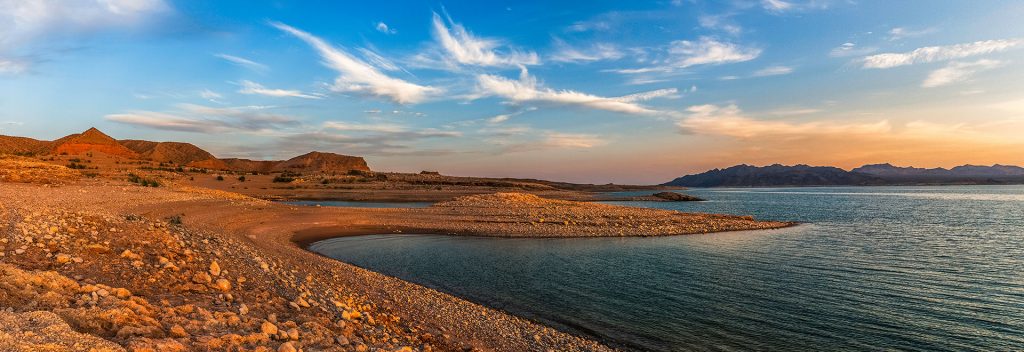
People who have been to Lake Mead say the most striking thing is the incredible contrast between its blue waters and the orange of the desert that surrounds it. The artificial basin basin in the United States is a boundless body of blue covering 640 square kilometres (247 square miles) in the middle of the desert. This lake created by the Hoover Dam on the Colorado River in 1931 is not just a vital infrastructure for Las Vegas and many other cities, but also a tourist and vacation destination. Last year, it attracted 7.5 million people.
About 20 million people depend on its waters and those of the Colorado River to survive, which will become more complicated in the years ahead because of the region’s risk of droughts and population growth.
Lake Mead and the Hoover Dam
Lake Mead’s water level has reached one of its historic lows in recent months. This is partly because of an increasingly drier climate, but also because more people than ever are using its water, as they have been doing without interruption since the construction of the Hoover Dam.
The Colorado River’s fate was decided in 1922 when, before the dam was built, the seven states through which the river passes (California, Arizona, Nevada, Colorado, Utah, Wyoming and New Mexico) agreed to divide up its water. The agreement paved the way for Congress to allocate the funds for the construction of the Hoover Dam. Secretary of Commerce Herbert Hoover (after whom the dam would later be named) overestimated the lake’s water capacity. He also did not take into account the increase in population that would occur in the future.
Today that agreement among the states has become difficult to maintain. The lake’s falling water levels and resulting reduction in water availability have forced local authorities to come up with an innovative plan to prevent Las Vegas from going dry.
Facing Lake Mead’s drought with the hydraulic tunnel by Salini Impregilo
The Southern Nevada Water Authority decided to cope Lake Mead’s drought by building a hydraulic tunnel, a unique example of a work of this kind that set a new engineering record.
To reach the centre of the lake, it was necessary to dig a tunnel four kilometres (2.4 miles) long to collect water from the lakebed that is then transported to Las Vegas, 30 kilometres (18 miles) away. This was a complex and risky project for those working on the tunnel, because the water pressure could reach 15 bars, far above the average of one to three bars.
The tunnel was completed by Salini Impregilo in a joint-venture with its U.S. subsidiary S.A. Healy. Today, it is up and running and provides Las Vegas with 4.5 million cubic metres (1.18 billion gallons) of drinking water per day. The project’s technical prowess has been recognized on several occasions. TBM magazine (Tunnel Business Magazine), one of the most prestigious in the tunneling sector, awarded it the “Tunneling Achievement Award of the Year” for the best project of 2016.
The largest recreational area in the United States
Lake Mead, near Las Vegas, is not just a source of water for Las Vegas, it is also the country’s largest recreational area. The lake sits in a 1.5-million-acre national park that includes mountains, canyons and valleys that extend up to the Hoover Dam.
This park was designed to be a tourist attraction where vacationers can boat, fish, ride a bike and hike along mountain paths.
Last year, 7.5 million people visited the Lake Mead National Recreation area, where the National Park Service has spent $1 billion to provide tourists with efficient transport infrastructure, places to eat and places to stay. As a result, the National Park Service says that visitors spend just under $300 million each year, supporting 4,000 jobs for people who live nearby.
Along with nature activities, visitors come to see tourist attractions like the digital museum about the history of the lake and its surrounding area, marked by adventurous explorers and pioneers seeking riches. The lake’s story goes back to prehistoric times, as demonstrated by the many archaeological finds of the last few years.
Lake Mead: from prehistory to the present
Long ago, the Nevada desert was a humid environment, much more comfortable in which to live than it is today, according to archaeological evidence found in the area going back 8,000-10,000 years. That is why it was settled by Native American communities, who cultivated the land and built their villages.
For centuries, the Colorado River has been an essential resource for the indigenous populations living along its banks. Through the centuries, they developed innovative irrigation techniques and methods.
The area’s development has always been based on the river, from its prehistoric origins right up until 1902 when the Reclamation Act was signed. This was a governmental act that laid the foundations for the construction of the Boulder Dam (later called Hoover Dam), which began nearly 30 years later, in 1931. Lake Mead was named after Elwood Mead, the commissioner of the Bureau of Reclamation who approved the construction of one the most important and historic dams in the United States.

